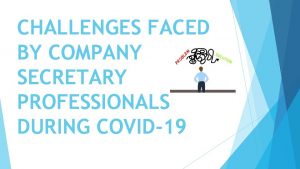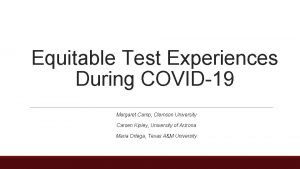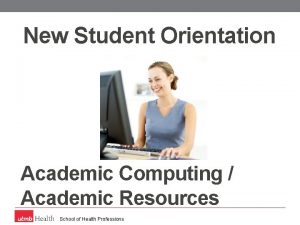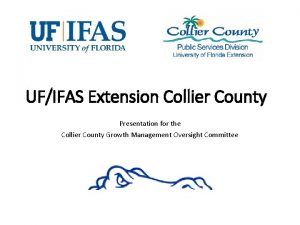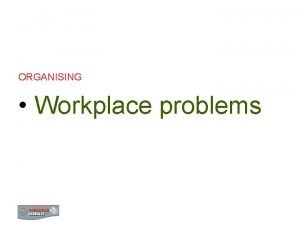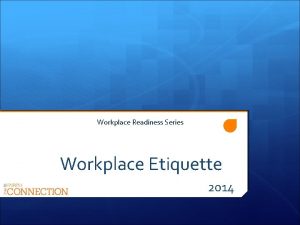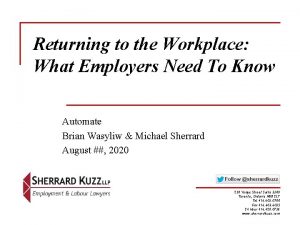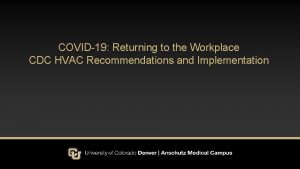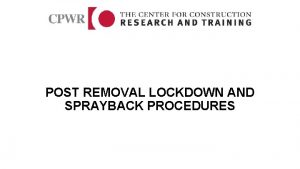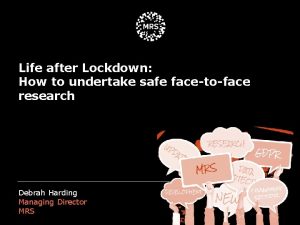Returning to the Workplace After Lockdown James Collier






















- Slides: 22

Returning to the Workplace After Lockdown James Collier, Employment Solicitor

AGENDA Ø UK Gov guidance on the COVID 19 roadmap out of lockdown Ø Managing COVID 19 risk in the workplace Ø Particular considerations for disabled and pregnant employees Ø Can I require a worker or employee to have a COVID 19 test or vaccination before attending work? Ø Your scenarios Ø Q&A

UK GOV SPRING 2021 ROADMAP (22 FEBRUARY 2021) • Step 1 – 29 March 2021 – open air sports and swimming pools open. • Step 2 – 12 April 2021 – non-essential business, pubs and restaurants serving outside, personal care businesses, zoos and theme parks, independent holiday accommodation open. • Step 3 – 17 May 2021 – most other businesses (except very high risk) including accommodation, indoor hospitality and entertainment businesses may open. • Step 4 – 21 June 2021 – large indoor performances and nightclubs may open; removal of all other legal restrictions on social contact.

UK GOV – SPRING 2021 ROADMAP (CONTINUED) • Working from home continues to be recommended until at least step 4 on 21 June 2021. • UK Gov workplace social distancing advice under review – potential for advice on intermittent distancing, increased use of masks and screens, continuation of hygiene advice. • 1 April 2021 – clinically extremely vulnerable no longer advised to shield and should return to the workplace if cannot work from home, no longer eligible for SSP if remain off work due to shielding. • Workplace CV 19 testing – 2 tests per week recommended, free tests until end June 2021, employers with under 50 employees can use NHS/LA asymptomatic testing services for staff. https: //www. gov. uk/government/publications/covid-19 -response-spring-2021

THE CURRENT STATE OF THE WORKPLACE, A YEAR ON FROM THE BEGINNING OF THE PANDEMIC The TUC’s April 2021 biennial survey of over 2, 100 workplace safety representatives reveals that workers are being placed at risk by employers who are failing to meet COVID-secure rules. • 27% of safety representatives surveyed were not involved at all in their employer's risk assessments – despite legal obligation on employer to involve them. • Only 31% believe that appropriate social distancing rules and physical barriers between colleagues in the workplace were being implemented by their employer all of the time. • Only 29% said that their employers were implementing appropriate distancing measures between employees and customers. • 65% have had to respond to growing numbers of mental health concerns since the pandemic began, with 70% citing stress as a workplace hazard. Source - TUC: Union Health and Safety Reps Survey 2020/2021 (April 2021) https: //www. tuc. org. uk/sites/default/files/2021 -03/Safety%20 reps%20 survey%202021. pdf)

WORKING SAFELY DURING CORONAVIRUS • The UK Gov non-statutory guidance, Working Safely During Coronavirus (COVID-19 Secure guidelines)* provides practical suggestions on reducing the risks of coronavirus transmission in 14 different types of workplace and can assist employers in carrying out their risk assessments. • There are 5 common themes throughout the 14 guidance notes. * https: //www. gov. uk/guidance/working-safely-during-coronavirus-covid-19)

WORKING SAFELY DURING CORONAVIRUS The five main themes applicable to most businesses and workplaces are: • Carry out a Covid-19 Risk Assessment; • Develop cleaning, handwashing and hygiene procedures; • Help employees work from home; • Maintain 2 -meter social distancing where possible; • Where this is not possible, manage transmission risk (think about ventilation of indoor environments)

EMPLOYERS’ STATUTORY AND COMMON LAW DUTIES IN RELATION TO HEALTH AND SAFETY • To ensure, so far as is reasonably practicable, the health, safety and welfare at work of all their employees • To take reasonable care for the safety of their employees, providing: Ø a safe place of work Ø safe tools and equipment Ø a safe system of working. • To take reasonable care of the health and safety of employees and provide a reasonably suitable working environment for the performance of the employee's contractual duties.

MANAGEMENT OF HEALTH AND SAFETY AT WORK REGULATIONS 1999 • Carry out a risk assessment. • Effective planning, organisation, control, monitoring and review of the preventive and protective measures. • Appropriate monitoring of any health and safety risks identified by the assessment. • Appoint a health and safety representative. • Establishment and use of procedures for situations where there is serious and imminent danger to persons at the place of work.

MANAGEMENT OF HEALTH AND SAFETY AT WORK REGULATIONS 1999 (CONTINUED) Information that employees must be made aware of include: • the risks to their health and safety identified by the assessment – the risk assessment; • the preventive and protective measures – the policy and procedure to follow in the vent of a serious or imminent danger in the workplace.

PROTECTIONS FOR EMPLOYEES RAISING HEALTH & SAFETY CONCERNS Right to make claims: • Detrimental treatment - section 44 of the Employment Rights Act 1996. • Unfair dismissal - section 100 ERA 1996. • Constructive dismissal – for breach of implied terms of the employment contract (duty of trust and confidence, duty to provide a safe system of work) • Possible disability (and other protected characteristics) discrimination claims. • Reporting of employer to the Health and Safety Executive for investigation of their complaint.

CAN EMPLOYERS LAWFULLY CONDUCT TEMPERATURE CHECKS ON EMPLOYEES, WORKERS OR VISITORS? • Yes, if there is a legitimate reason for doing so – usually provided for within the contract of employment and relevant health and safety policy. • But health testing requires informed consent. If consent is not provided, the employer could be vulnerable to constructive unfair dismissal claims and even to a criminal charge of assault and battery. • Employers must handle employees' personal data with care and in compliance with the Data Protection Act 2018 and GDPR.

CAN EMPLOYERS REQUIRE EMPLOYEES TO TAKE A COVID -19 TEST AT WORK OR BEFORE RETURNING TO WORK? • Current UK GOV recommendations are for employees to take two “rapid flow” tests per week. • Important to educate, train and possibly incentivise the workforce – to overcome sense of unnecessary invasion of privacy. • Requirement could be introduced as part of policy changes to reflect the new COVID-19 working conditions, or included as a contractual requirement in future employment contracts. • Advisable to consult and engage with employees and secure their written agreement before inserting such a requirement into existing employment contracts or updating internal policy.

CAN AN EMPLOYER REQUIRE STAFF TO TAKE CV 19 VACCINATION? • No, CV 19 vaccination is voluntary and requires informed consent. • Could be mandated as a term of new employment contracts, but ACAS advises against this. • Such a policy risks challenge on the grounds of indirect discrimination – placing individuals who share a protected characteristic (age, disability, pregnancy, sex, race, religion) at a particular disadvantage - and may not be objectively justified by the employer. • Requiring current employees to be vaccinated may trigger Tribunal claims for repudiatory breach of contract and indirect discrimination.

VACCINATION (CONTINUED) Things to consider : • Vaccination is not suitable for everyone e. g. pregnant women or those ill with CV 19. • A mandatory vaccination policy may not be justifiable – perhaps best to target roles with a demonstrable risk e. g. where social distancing is difficult. • The employer may be able to facilitate voluntary vaccination by: • collective consultation with a recognised trade union/employee health and safety representatives; • a proactive communication strategy; • incentivising vaccination – e. g. paid time off for the vaccination, paid leave if the worker suffers side effects.

COVID 19 AND PREGNANT EMPLOYEES Employer has legal duties towards expectant mothers in the workplace: • To assess workplace risks posed to the mother or her baby. • To alter the working conditions or hours to avoid any significant risk. • If not reasonable to do this, or would not avoid the risk, to offer suitable alternative work on terms that are not “substantially less favourable”. • Where suitable alternative work is not available, or the employee reasonably refuses it, to suspend the employee on full pay. Requiring pregnant employees to continue to work in front line roles could amount to indirect discrimination. UK Gov advice: https: //www. gov. uk/government/publications/coronavirus-covid-19 advice-for-pregnant-employees/coronavirus-covid-19 -advice-for-pregnant-employees

COVID 19 AND DISABLED EMPLOYEES Disability status and CV 19 clinically extremely vulnerable (CEV) status differences: • Disability – must satisfy section 6 Equality Act 2010 criteria for disability status, or have a deemed disability (cancer, MS, HIV). • CEV – transplant recipients, respiratory/some cancer diseases, immunosuppression conditions etc. on UK Gov CEV list • Symptoms related to ”long covid” may amount to a disability if cause long term substantial adverse effects on the employee’s ability to carry out their usual daily activities

COVID 19 – DISABLED EMPLOYEES Employers’ legal duties towards disabled employees: • To make reasonable adjustments to policies, criteria, practices, or physical features of the workplace, or provide an auxiliary aid, if disabled employee is substantially disadvantage by them. • Not to treat the disabled employee unfavourably because of something that arises in consequence of their disability (discrimination arising from disability) • Not to treat the disabled person less favourably because of their disability (direct discrimination claim). • By acts or omissions related to the disability, that have the effect of violating the disabled worker’s dignity or create an intimidating, hostile, degrading work environment (disability-related harassment claim). • Not to apply policies and procedures that cause disable employees a particular disadvantage and that cannot be objectively justified (indirect discrimination)

COVID 19 – DISABLED EMPLOYEES Recommended Advice to employers: • Keep all evidence of related individual risk assessments and health information including GP/OH reports. • Ensure there is a written record of agreed adjustments. • Retain documentary evidence showing consideration to the employee’s stated needs and concerns and details of the taking of reasonable steps to provide the adjustments identified in any of the assessments • Provide training on equal opportunities and managing disabled employees to staff, particularly managers and keep evidence of providing this training – helpful if employer seeks to rely on the reasonable steps defence to a discrimination claim

YOUR SCENARIOS

Q/A • Any questions?

THANK YOU! CONTACT ( 020 7228 0017 * james. collier@hanne. co. uk þ www. hanne. co. uk
 If any man comes after me
If any man comes after me After me after me after me
After me after me after me I conclude then returning to being feared and loved
I conclude then returning to being feared and loved Returning back to god
Returning back to god Returning warrior workshop
Returning warrior workshop Land of the morning
Land of the morning Huntsville cs powerschool
Huntsville cs powerschool A value-returning function is
A value-returning function is Leaving returning
Leaving returning Ut tyler letter of appreciation
Ut tyler letter of appreciation Challenges faced by company secretary during lockdown
Challenges faced by company secretary during lockdown Umkc qualtrics
Umkc qualtrics Challenges faced by company secretary
Challenges faced by company secretary Acrostic poem on lockdown
Acrostic poem on lockdown Biscuit dunking investigation
Biscuit dunking investigation Https://www.bbc.com/news/uk-england-bristol-53553784
Https://www.bbc.com/news/uk-england-bristol-53553784 Challenges faced by company secretary during lockdown
Challenges faced by company secretary during lockdown Margaret camp clemson
Margaret camp clemson Utmb citrix
Utmb citrix Classroom lockdown solutions
Classroom lockdown solutions Cara membaca fenogram
Cara membaca fenogram Device lockdown windows 10
Device lockdown windows 10 What does alice training mean
What does alice training mean












